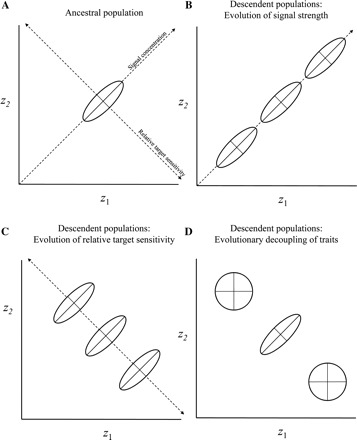Fig. 1.

Relationships between two phenotypic variables mediated by the same hormone. In (A) two traits in a hypothetical population, z1 and z2, are correlated, as represented by the ellipse. Mechanistically, the correlation is mediated by variation in a signal (e.g., hormone concentration), which determines the major axis of the ellipse. The minor axis of the ellipse is determined by variation in the relative sensitivity of the target tissues involved in the expression of the trait. In other words, residual variation is mediated by the extent to which the tissues involved in z1 expression differ in sensitivity from those involved in z2 expression. In (B–D), the ancestral population has given rise to two new populations where evolution of the hormonal suite has occurred. In (B), only the strength of the signal has evolved. In each descendant population, the means of z1 and z2 have evolved in the same direction, such that population means are correlated across populations in the same way as are individuals within populations. Note that such a pattern could also occur by coordinated evolution of target sensitivities (i.e., both z1 and z2 tissues become more or less sensitive). In (C), evolution has occurred primarily by adjusting the relative sensitivity of targets. In the right-hand population, the target(s) that affect z1 have become more sensitive while the target(s) that affect z2 have become less sensitive; and in the left-hand population, the target(s) that affect z2 have become more sensitive while the target(s) that affect z1 have become less sensitive. The means of z1 and z2 have evolved in opposite directions. Co-variation within populations is unchanged, but population means are no longer correlated in the same way. In (D), one trait has become dissociated from the hormonal suite altogether, perhaps by loss of sensitivity of the target to the signal. The two traits are no longer correlated in either of the derived populations, and the means of the two traits have evolved in opposite directions.
